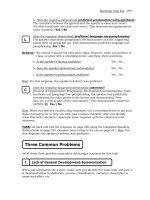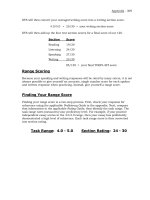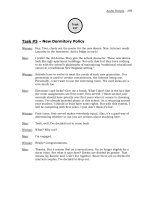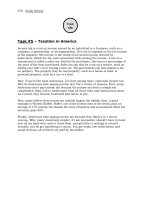Engineering of an efficient and enantioselevtive biocatalyst for the preparation of chiral pharmaceutical intermediates
Bạn đang xem bản rút gọn của tài liệu. Xem và tải ngay bản đầy đủ của tài liệu tại đây (4.99 MB, 174 trang )
ENGINEERING OF AN EFFICIENT AND ENANTIOSELECTIVE
BIOCATALYST FOR THE PREPARATION OF CHIRAL
PHARMACEUTICAL INTERMEDIATES
TANG, WENG LIN
(B.Eng.(Hons.)), NUS
A THESIS SUBMITTED
FOR THE DEGREE OF DOCTOR OF PHILOSOPHY
DEPARTMENT OF CHEMICAL AND BIOMOLECULAR ENGINEERING
NATIONAL UNIVERSITY OF SINGAPORE, SINGAPORE
AND
UNIVERSITY OF ILLINOIS, AT URBANA-CHAMPAIGN, ILLINOIS, USA
2011
ii
Abstract
This Ph.D. thesis focuses on the engineering of an efficient and
enantioselective biocatalyst via direct evolution and genetic engineering for the
enantioselective hydroxylation of non-activated carbon atom, a useful but challenging
reaction for the synthesis of chiral pharmaceutical intermediates. Our target enzyme is
the novel P450pyr enzyme from Sphingomonas sp. HXN-200 that was found to
catalyze the regio- and stereoselective hydroxylation of non-activated carbon atom
with broad substrate range, high activity, excellent regioselectivity, and good to
excellent enantioselectivity. Our target reaction is the enzymatic hydroxylation of N-
benzyl pyrrolidine to its corresponding (R)- and (S)-N-benzyl-3-hydroxypyrrolidines
which are important pharmaceutical intermediates.
In this thesis, a two-enzyme-based colorimetric high-throughput ee screening
assay and a mass spectrometry-based high-throughput ee screening assay were
developed. The P450pyr monooxygenase was engineered by directed evolution for
the enantioselective hydroxylation of N-benzyl pyrrolidine. Several mutants
exhibiting increased and/or inverted enantioselectivity were identified, with
product ee of 83% (R) and 65% (S) for mutants 1AF4A and 11BB12, respectively.
The wild type P450pyr and its mutants were also purified and reconstituted with their
auxiliary electron transport proteins, ferredoxin and ferredoxin reductase in vitro. The
mutants were then used to catalyze the hydroxylations of a range of different
substrates using whole-cell assays to investigate the changes in product ee. In addition,
an efficient biocatalytic system with cofactor recycling was developed by co-
expressing a glucose dehydrogenase from Bacillus substilis or a phosphite
iii
dehydrogenase from Pseudomonas stutzeri together with the P450pyr system in a
recombinant Escherichia coli.
iv
To Papa, Mama, Jun Jun
and Pippo
v
Acknowledgements
This Ph.D. thesis would not have been possible without my advisors,
Associate Professor Zhi Li and Professor Huimin Zhao, whose constant guidance,
great patience and understanding have led me through to the completion of my
graduate career.
In particular, I am indebted to Dr. Sheryl Rubin Pitel who taught me the basics
of molecular biology and how to conduct high quality research. Special thanks to Dr.
Yongzheng Chen who worked with me on the high-throughput mass spectrometry-
based assay and for helping me to synthesize various chemical compounds for my
biocatalysis work. I would also like to thank Dr. Ryan Sullivan, Dr. Nikhil Nair, Dr.
Yoo-Seong Choi, Dr. Zengyi Shao, Dr. Michael McLachlan and Dr. Zunsheng Wang
for their helpful discussions and extremely useful suggestions. A big thank you to
Carl Denard, Luigi Chanco, Ryan Cobb, Ning Sun, Dr. Byoungjin Kim, Liang Xue,
Wei Zhang, Wen Wang, Quang Son Pham and all the current and former members of
Prof. Huimin Zhao’s and Prof. Zhi Li’s laboratory for their wonderful friendship and
for making my Ph.D. life interesting and wonderful.
Lastly but most importantly, I would like to thank my family for their love,
support and encouragement. Everything that I have achieved today would not have
been possible without them.
vi
Table of Contents
Chapter 1 : Introduction 1
1.1 Industrial Biotechnology 1
1.2 Chemo-, Regio- and Enantioselective Biocatalysis 2
1.3 Enzymatic Hydroxylation of Non-Activated Hydrocarbons 5
1.3.1 Cytochrome P450 Monooxygenase 5
1.3.2 Methane Monooxygenases 8
1.3.3 Membrane-bound Alkane Hydroxylase (AlkB) 9
1.4 Protein Engineering 9
1.4.1 Rational Design 10
1.4.2 Directed Evolution 11
1.4.3 Screening and Selection 14
1.5 Cofactor Regeneration 24
1.5.1 NAD(P)H Regeneration 25
1.6 Project Overview 27
Chapter 2 : Development of a High-throughput Enantiomeric Excess (ee)
Screening Assay 31
2.1 Introduction 31
2.2 Two-Enzyme-Based Colorimetric ee Screening Assay 33
2.2.1 Results and Discussion 33
2.2.2 Conclusion and Outlook 38
2.3 Mass Spectrometry-Based High-Throughput ee Screening Assay 39
2.3.1 Results and Discussion 39
vii
2.3.2 Conclusion 44
2.4 Materials and Methods 45
2.4.1 Two-Enzyme-Based Colorimetric ee Screening Assay 45
2.4.2 Mass Spectrometry-Based High-Throughput ee Screening Assay 49
Chapter 3 : Inverting the Enantioselectivity of P450pyr Monooxygenase by
Directed Evolution 63
3.1 Introduction 63
3.2 Results 65
3.2.1 Homology Modeling 65
3.2.2 Cloning and Expression of Cytochrome P450pyr Electron Transport
System 70
3.2.3 Iterative Targeted Site Saturation Mutagenesis 72
3.2.4 Screening strategy 74
3.2.5 Combination of Beneficial Mutations by Site Directed Mutagenesis 78
3.3 Discussion 78
3.3.1 Evolutionary Strategy 78
3.3.2 Structural Analysis of Mutations 80
3.4 Conclusions and Outlook 81
3.5 Materials and Methods 82
Chapter 4 : Development of a Simple, Efficient and General Method for Cofactor
Recycling in a Bio-Oxidation 90
4.1 Introduction 90
4.2 Results and Discussion 92
4.2.1 Construction of Recombinant E. coli Strains 92
4.2.2 Cell Culture and Protein Expression 95
viii
4.2.3 Biohydroxylation of N-Benzyl-pyrrolidine 1 with Recombinant E. coli
Strains Expressing the P450pyr and Cofactor Regeneration System 96
4.2.4 Biohydroxylation of N-Benzyl-pyrrolidin-2-one 3 with Recombinant E.
coli Strains Expressing the P450pyr and Cofactor Regeneration System 101
4.3 Conclusion and Outlook 108
4.4 Materials and Methods 110
Chapter 5 : Further Characterization of P450pyr and Related Mutants 115
5.1 Introduction 115
5.2 Results 117
5.2.1 Cloning, Expression, and Purification of WT P450pyr and Its Mutants
117
5.2.2 In vitro Kinetic Analysis 118
5.2.3 Biohydroxylation of Mutant P450s with Different Substrates 125
5.3 Discussion 129
5.4 Conclusion and Outlook 130
5.5 Materials and Methods 130
Chapter 6 : Conclusion and Recommendations 138
6.1 Conclusion 138
6.2 Recommendations/ Future Work 140
References 143
Appendix: Publications and Oral Presentations 160
ix
List of Tables
Table 1.1. Biotransformations developed by the pharmaceutical industry. 4
Table 1.2. Summary of the advantages and disadvantages of selected directed
evolution methods 12
Table 2.1. Product ee of the biohydroxylation of 1 to 2 with different biocatalysts
established by an LC-MS-based assay. 43
Table 3.1. Conversion of substrates N-Benzyl-pyrrolidine 1 and N-
benzyloxycarbonyl-pyrrolidine using a whole-cell system. 72
Table 3.2. Hydroxylation of N-benzyl pyrrolidine 1 by engineered cytochrome
P450pyr variants. 77
Table 3.3. Effect of combination of mutations on substrate conversion and ee 78
Table 4.1. Various E. coli BL21(DE3) strains with 2- and 3-plasmid systems 93
Table 4.2. Specific activity for the biohydroxylation of 1 by various strains with the
GDH and PTDH 12x systems. 98
Table 4.3. Specific activity of various strains with the GDH and PTDH 12x systems
102
Table 4.4. Construction of different plasmids. Primers and restriction sites used are
shown below 111
Table 5.1. Optimizing the ratio of P450:Fdx:FdR. 119
Table 5.2. Steady state kinetic parameters of WT P450pyr and its mutants 1AF4,
1AF4A and 11BB12 119
Table 5.3. Product ee of various substrates. 126
Table 5.4. Primers and templates used to amplify 7 different genes 132
x
List of Figures
Figure 1.1 A functional gap that exists between the naturally occurring enzymes and
the commercially viable enzymes needs to be bridged. 10
Figure 1.2. A typical screening procedure in a 96-well microtiter plate format 15
Figure 1.4. Schematic organization of Class I P450s. 28
Figure 2.1. SDS-PAGE of purified N-histag BRD and N-histag RDR. 35
Figure 2.2. Codon optimized sequence of the RDR gene. 36
Figure 2.3. Graph shows the linear correlation between y value and ee 37
Figure 2.4. LC-MS analysis of the product from biohydroxylation of (R)- and (S)-3
with Sphingomonas sp. HXN-200, respectively. 43
Figure 2.5. LC-MS chromatogram of biohydroxylation (S)-3 with Sphingomonas sp.
HXN-200 57
Figure 2.6. LC-MS chromatogram of biohydroxylation (R)-3 with Sphingomonas sp.
HXN-200 58
Figure 2.7. LC-MS chromatogram of biohydroxylation (S)-3 with 1AF4 59
Figure 2.8. LC-MS chromatogram of biohydroxylation (R)-3 with 1AF4 60
Figure 2.9. LC-MS chromatogram of biohydroxylation (S)-3 with P. oleovorans GPo1
61
Figure 2.10. LC-MS chromatogram of biohydroxylation (R)-3 with P. oleovorans
GPo1 62
Figure 3.1. Application of (R)- and (S)-N-protected 3-hydroxypyrrolidines. 64
Figure 3.2. Partial sequence alignment of P450pyr with members of the P450 family
67
Figure 3.3. Clustal W dendrogram of P450pyr with other members of the P450 family.
67
Figure 3.4. Structure comparison of P450pyr (a) with P450terp (b), CYP119 (c),
P450st (d), P450cam (e), and P450nor (f). 69
Figure 3.5. Surface around the P450pyr active site. 70
Figure 3.6. pRSFDuet P450pyr and pETDuet Fdx FdR expression vector 71
xi
Figure 3.7. SDS-PAGE analysis 72
Figure 3.8. (a) Homology model showing the 17 residues that were identified within
5Å of the heme-docked substrate. (b) The mutation sites are shown 74
Figure 3.9. Example of 96-well microtiter plate screening using the BRD and RDR
enzymes coupled with the NBT-PMS assay. 76
Figure 3.10. General scheme of the overlap extension PCR method that was used to
introduce site-directed mutations to the template. 89
Figure 4.1. Selected examples of plasmid maps 94
Figure 4.2. SDS-PAGE of non-induced R12x control (lane 1), Rgdh (lane 2), R12x
(lane 3) and A2 (lane 4) 95
Figure 4.3. GDH cofactor regeneration system. 99
Figure 4.4. PTDH 12x cofactor regeneration system. 100
Figure 4.5. GDH cofactor regeneration system. 104
Figure 4.6. PTDH 12x cofactor regeneration system. 105
Figure 4.7. Comparison of strain productivity (for Ap450, Agdh and A12x) with
different starting concentration of substrate 3 106
Figure 4.8. Plot of product concentration (mM) versus time (h). 107
Figure 5.1. SDS-PAGE of purified proteins. 118
Figure 5.2. Michaelis-Menten plot for WT P450pyr. 121
Figure 5.3. Michaelis-Menten plot for 11BB12. 122
Figure 5.4. Michaelis-Menten plot for 1AF4. 123
Figure 5.5. Michaelis-Menten plot for 1AF4A. 124
Figure 5.6. Hydroxylation scheme of various substrates to their respective products.
125
Figure 5.7. Chiral HPLC spectra for the biohydroxylation with substrate 11. 127
Figure 5.8. Chiral HPLC spectra for the biohydroxylation with substrate 13. 128
xii
List of Schemes
Scheme 1.1. General hydroxylation reaction catalyzed by P450 monooxygenases. 6
Scheme 2.1. A high-throughput two-enzyme based colorimetric ee assay for
asymmetric biohydroxylation of prochiral substrate N-benzyl pyrrolidine 1 to its
corresponding products (R)- and (S)-1-benzyl-3- pyrrolidinol 2. The formation of
formazan corresponded to the activity of the dehydrogenases that in turn correlated to
the concentration of each enantiomer in the aqueous solution. 34
Scheme 2.2. The principle of a high-throughput enantioselectivity assay for the
biohydroxylation of a symmetric substrate based on the use of enantiopure deuterated
substrates and MS detection 42
Scheme 2.3. Synthesis of (R)- and (S)-1-benzyl pyrrolidine-3-d 3. 42
Scheme 4.1. Biohydroxylation of substrate N-benzyl pyrrolidine 1 to its
corresponding (R)- and (S)-N-benzyl-3-hydroxypyrrolidines 2 with NADH
regeneration using (a) phosphite dehydrogenase (PTDH 12x) and (b) glucose
dehydrogenase (GDH). 97
Scheme 4.2. Biohydroxylation of substrate N-benzyl-pyrrolidin-2-one 3 to its
corresponding (S)- and (R)-N-benzyl-4-hydroxypyrrolidin-2-ones 4 with NADH
regeneration using (a) phosphite dehydrogenase (PTDH 12x) and (b) glucose
dehydrogenase (GDH). 102
xiii
List of Abbreviations
Amp ampicillin
BSA bovine serum albumin
cdw cell dry weight
Cm chloramphenicol
epPCR error-prone polymerase chain reaction
HEPES 4-(2-hydroxyethyl)-1-piperazineethanesulfonic acid
HPLC high-performance liquid chromatography
IMAC immobilized metal affinity chromatography
IPTG isopropyl-β-D-thiogalactospyranoside
Kan kanamycin
LB Luria-Bertani
MS mass spectrometry
LC-MS liquid chromatography-mass spectrometry
NAD
+
nicotinamide adenine dinucleotide
NADH reduced nicotinamide adenine dinucleotide
NADP
+
nicotinamide adenine dinucleotide phosphate
NADPH reduced nicotinamide adenine dinucleotide phosphate
NBT nitroblue tetrazolium
PCR polymerase chain reaction
PEG polyethylene glycol
PMS phenazine methosulfate
PTDH phosphite dehydrogenase
Sm streptomycin/spectinomycin
SDS-PAGE sodium dodecyl sulfate-polyacrylamide gel electrophoresis
xiv
TB Terrific broth
WT wild type
Amino Acid Abbreviations
A alanine
C cysteine
D aspartate
E glutamate
F phenylalanine
G glycine
H histidine
I isoleucine
K lysine
L leucine
M methionine
N asparagine
P proline
Q glutamine
R arginine
S serine
T threonine
V valine
W tryptophan
Y tyrosine
1
Chapter 1 : Introduction
1.1 Industrial Biotechnology
Industrial biotechnology, also known as white biotechnology, is the
application of modern biotechnology to the sustainable production of chemicals
(which includes fine chemicals and pharmaceuticals), materials, and fuels from
renewable sources, using living cells and/or their enzymes. This field is widely
regarded as the third wave of biotechnology, distinct from the first two waves
(medical or red biotechnology and agricultural or green biotechnology). Much
interest has been generated in this field mainly because industrial biotechnology is
often associated with reduced energy consumption, greenhouse gas emissions, and
waste generation, and also may enable the paradigm shift from fossil fuel-based to
bio-based production of value-added chemicals.
The fundamental force that drives the development and implementation of
industrial biotechnology is the market economy, as biotechnology promises highly
efficient processes at lower operating and capital expenditures. In addition, political
and societal demands for sustainability and environment-friendly industrial
production systems, coupled with the depletion of crude oil reserves and a growing
world demand for raw materials and energy, will continue to drive this trend forward.
1
McKinsey & Company predicted that in 2010 industrial biotechnology will account
for 10 percent of sales within the chemical industry, amounting to US$125 billion in
value ( In the US,
bio-based pharmaceuticals account for the largest share of the biotechnology market
followed by bio-ethanol, other bio-based chemicals, and bio-diesel.
2
Other major
2
players in industrial biotechnology include the European Union,
3,4
China, India, and
Brazil. In China alone, the value of bio-based chemical products exceeded US$60.5
billion in 2007.
5
Government policies including tax incentives, mandatory-use regulations,
research and development, commercialization support, loan guarantees, and
agricultural feedstock support programs have helped fuel the adoption of industrial
biotechnology. Moreover, breakthroughs in enzyme engineering, metabolic
engineering, synthetic biology, and the expanding ‘omics’ toolbox coupled with
computational systems biology are expected to speed up industrial application of
biotechnology. These advances have provided scientists with toolsets to engineer
enzymes and whole-cells, by expanding the means to identify, understand and make
perturbations to the complex machinery within the microorganisms.
1.2 Chemo-, Regio- and Enantioselective Biocatalysis
Biocatalysis is one of the oldest chemical transformations known to humans,
with the oldest records of brewing dating back to about 6000 years ago. The
employment of enzymes and whole-cells in chemical, pharmaceutical, as well as food,
textile and paper industries is increasing rapidly. Whole-cells are often used in
reactions which require the regeneration of expensive cofactors, whereas isolated
enzymes are typically used for hydrolytic or isomerization reactions. Nevertheless, in
industrial settings, whole-cells are usually preferred over purified enzymes, even for
single step transformations, to avoid enzyme purification costs.
Biocatalysis offers several significant advantages over chemocatalysts. Firstly,
since enzymes function at moderate temperatures and pressures, they require less
3
energy input. Secondly, enzymes can be extremely fast, increasing reaction rates by 4
to 12 orders of magnitude. In some cases, enzymes can be so fast that their turnover
rates are limited only by diffusion of substrate(s) and product(s) to and from the active
site. Thirdly, since biocatalysts are biodegradable and rarely contain heavy metals,
waste streams are much more manageable, requiring minimal treatment. Fourthly,
since most biocatalysts function in aqueous media, effluent volatile organic
compound (VOC) emissions from production plants can be drastically reduced. Lastly
but most importantly, enzymes can be highly selective (regio-, diastereo-, enantio-, or
chemo-), and thus are able to replace multistep reactions or difficult purification
schemes. This can circumvent the need for many blocking and deblocking steps that
are required for stereo- or regio-selective reactions.
The high selectivities of enzyme make them attractive for industrial
applications due to its increased product concentrations and productivities besides
having no undesirable by-products. Despite the considerable progress in chiral
synthesis, organic chemists are still struggling with the complexity of using traditional
organic chemistry to synthesize chiral compounds. Thus, the focus is now switched to
biocatalysis - a simple yet efficient method to synthesize enantiopure compounds as
chiral building blocks for drugs and agrochemicals. The use of biocatalysis to produce
enantiopure compounds can be divided into two approaches: (1) kinetic resolution of
a racemic mixture where the enzyme is used to convert one of the enantiomers at a
higher reaction rate than the other enantiomer; and (2) asymmetric biocatalysis
starting with a prochiral substrate to produce different enantiomers in different
quantities.
4
Chirality is a very important factor in the efficacy of many drug products. A
survey of major pharmaceutical companies such as GlaxoSmithKline (UK),
AstraZeneca (UK) and Pfizer (US) showed that more than half of the drug compounds
examined contained one or more chiral centers.
6
Furthermore, an enantiomeric purity
of at least 99.5% is often necessary to meet regulatory requirements. Selectivities
of >95% are difficult to achieve by chemocatalysis and, if essential to synthesis,
would require the use of biocatalysis. At present, 22 of 38 large-scale asymmetric
syntheses already incorporated biocatalysis.
7
Recognizing its importance, many fine
chemical and pharmaceutical companies have started to focus on acquiring
biocatalysis expertise (Table 1.1), and those that have already done so are trying to
maintain their positions as technological leaders.
Table 1.1. Biotransformations developed by the pharmaceutical industry.
8
Target compound Company Reaction Biocatalyst
SCH56592 Schering Plough Acylation CALB
β-Lactams Glaxo Smith Kline Acylation CALB
Lotrafiban Glaxo Smith Kline Hydrolysis CALB
Paclitaxel Bristol-Myers
Squibb
Hydrolysis
Pseudomonas
lipase AK
P. cepacia lipase
PS-30
HMG-CoA
reductase inhibitor
Bristol-Myers
Squibb
Acylation P. cepacia lipase
PS-30
SCH66336 Schering Plough Acylation
P. aeruginosa
lipase
Xemilofiban Monsanto Hydrolysis E. coli penicillin
acylase
Renin inhibitor Hoffmann La
Roche
Hydrolysis B. licheniformis
subtilisin
Lamivudine Glaxo Smith Kline Hydrolysis E. coli cytidine
deaminase
AG7088 Pfizer Reduction L. mesenteroides D-
LDH
C. boidinii FDH
5
ACE inhibitor Ciba-Geigy Reduction S. epidermis D-
LDH
LY300164 Eli Lilly Reduction
Z. rouxii
dehydrogenase
Omapatrilat Bristol-Myers
Squibb
Reductive
amination
T. intermedius PDH
N-Butyl DNJ Pharmacia Oxidation G. oxydans SDH
2-Quinoxaline-
carboxylic acid
Pfizer Oxidation A. repens MO
HMG-CoA
reductase inhibitor
Merck Sharp and
Dohme
Oxidation N. autotropica MO
Lobucavir prodrug Bristol-Myers
Squibb
Regioselective
acylation
B. licheniformis
subtilisin
CALB: Candida antartica lipase, FDH: formate dehydorgenase, D-LDH: D-lactate dehydrogenase, MO:
monooxygenase, PDH: phenylalanine dehydrogenase, SDH: sorbitol dehydrogenase.
1.3 Enzymatic Hydroxylation of Non-Activated Hydrocarbons
Regio- and stereoselective hydroxylations of non-activated carbon atoms
represent a significant challenge in classical organic chemistry.
9
However, this
reaction can be carried out via biocatalysis with monooxygenases using molecular
oxygen as oxidant. Several monooxygenases such as cytochrome P450cam, P450BM-
3, methane monooxygenases (MMO) and membrane-bound alkane hydroxylase (alkB)
have been extensively investigated. These biohydroxylations are very useful for the
preparation of enantiopure compounds that are useful pharmaceutical intermediates.
1.3.1 Cytochrome P450 Monooxygenase
First discovered about 50 years ago, cytochrome P450 enzymes constitute the
largest superfamily of heme-containing monooxygenases (E.C.1.14 ) that have the
ability to oxidize a broad range of substrates, often at non-reactive carbon centers.
10
The name cytochrome P450 is derived from the following: cytochrome stands for a
hemoprotein, P for pigment, and 450 reflects the absorption peak of the reduced CO-
6
bound complex at 450 nm. Cytochrome P450s are widely distributed in prokaryotes
and eukaryotes, with over 11,000 P450s identified to date
( The sequence of the P450
polypeptide chain can be quite diverse with P450s from the same family differing by
up to 60% in their amino acid sequence.
P450 enzymes can be divided into four classes, depending on their redox
partners. Class I P450s include most bacterial monooxygenases that require a FAD-
containing reductase and an iron sulfur redoxin (P450cam from Pseudomonas putida).
Class II enzymes require only a FAD/FMN-containing P450 reductase for the transfer
of electrons and are found mostly attached to the endoplasmatic reticulum. P450BM-3
from Bacillus megaterium, CYP102A2 from Bacillus subtilis and CYP505from
Fusarium oxysporum belong to this class of enzymes. They are self-sufficient as they
contain the P450 monooxygenase and the reductase domain on a single peptide chain.
Class III enzymes are self-sufficient and require no electron donor as they convert
peroxygenated substrates that already contain oxygen. Meanwhile, P450s from class
IV receive electrons directly from NAD(P)H (P450nor from F. oxysporum).
The most common hydroxylation reaction catalyzed by cytochrome P450 is
the insertion of one atom of oxygen into a nonactivated carbon atom of an organic
substrate (RH), which is not possible by standard chemical methods, while the other
oxygen atom is reduced to water.
R-H + O
2
+2e
-
+2H
+
P
450
R-OH + H
2
O
NAD(P)H
NAD(P)
+
Scheme 1.1. General hydroxylation reaction catalyzed by P450 monooxygenases.
7
The catalytic turnover of cytochrome P450 begins with the binding of
substrate followed by the introduction of the first electron from NADPH via an
electron transfer chain.
11
Next, the oxygen binds and accepts a second electron to
produce a ferric peroxy anion. This anion is protonated to form the ferric hydroperoxy
complex, which is subjected to a heterolytic cleavage with the formation of a putative
ferryl species, equivalent to a Fe(V)=O species. This reactive electrophilic iron-oxo
intermediate then attacks the substrate to yield the hydroxylated product, which
dissociates to allow the cycle to begin again.
Cytochrome P450s are involved in the biotransformation of drugs, the
bioconversion of xenobiotics, the metabolism of chemical carcinogens, the
biosynthesis of physiologically important compounds such as steroids, fatty acids,
eicosanoids, fat-soluble vitamins, bile acids, the conversion of alkanes, terpenes and
aromatic compounds as well as the degradation of herbicides and insecticides.
11
P450s
are involved in diverse reactions including hydroxylation, N-, O-, S-dealkylation,
sulphoxidation, epoxidation, deamination, desulphuration, dehalogenation,
peroxidation and N-oxide reduction.
12
P450s can also catalyze multi-step reactions.
One example is the transformation of artemisinic acid, a precursor of the antimalarial
drug artemisin, by CYP71AV1.
13
In this example, amorpha-4,11-diene, a natural
product of E. coli or Saccharomyces cerevisiae, was initially hydroxylated twice by
CYP71AV1. The hydroxylation product was spontaneously dehydrated to form an
aldehyde which was subsequently converted by CYP71AV1 to form artemisinic acid.
In another example, P450
scc
was used to convert cholesterol by two successive
hydroxylation reactions into (20R, 22R),20,22-dihydroxycholesterol. The P450
scc
was
then used to catalyze the C-C bond cleavage to yield prenenolone and isocaproic
8
acid.
14
Despite the large application scope of P450 enzymes as biocatalysts, they are
rarely implemented in industrial processes mainly due to their instability, complexity
and often low catalytic turnover.
15
Nevertheless, with the increasing advancement in
the powerful methodologies of genetic engineering, P450 enzymes can now be
engineered with tailor-made properties, such as the engineering of recombinant
expression, physical properties, catalytic activity and interactions with redox
partners.
16
1.3.2 Methane Monooxygenases
Methane monooxygenase (MMO) belongs to the class of oxidoreductase
enzymes (EC 1.14.13.25) and is able to oxidize the C-H bond in methane as well as
other alkanes. There are two well-investigated forms of MMO: the soluble form
(sMMO) and the particulate form (pMMO). The active site in sMMO contains a di-
iron center bridged by an oxygen atom (Fe-O-Fe), whereas the active site in pMMO
utilizes copper. Over the decades, intensive investigation of these hydroxylation
reactions have been carried out either with the methanogenic microorganisms or
purified enzymes.
17,18
Methane monooxygenases (MMOs) isolated from
Methylococcus capsulatus Bath and Methylosinus trichosporium OB3b are found to
be able to hydroxylate simple alkanes with NADH as cofactor.
19
The MMO from
Methylococcus capsulatus is able to hydroxylate a series of simple alkanes to alcohols,
such as n-pentane to (R)-2-pentanol, although the yields are significantly reduced with
increasing chain lengths in the substrates.
17
9
1.3.3 Membrane-bound Alkane Hydroxylase (AlkB)
AlkB is an integral membrane non-heme iron protein that was first discovered
in a hexane-degrading pseudomonad known as Pseudomonas putida GPo1.
20
The
AlkB system consists of three components: the AlkB monooxygenase, rubredoxin and
the electron-providing NADH-dependent flavoprotein rubredoxin reductase. The
AlkB enzymes are very diverse and have different substrate ranges with the capability
to oxidize C
5
to C
16
n-alkanes, as well as branched, cyclic aliphatic and aromatic
compounds.
21
Extensive work has been carried out to understand the structure-
function relationship of this class of enzyme. One interesting example is a protein
engineering study where a tryptophan residue located in the middle of one of six
transmembrane helices was found to limit the length of the alkane substrates.
22
1.4 Protein Engineering
One of the most important tools for industrial biotechnology is protein
engineering. More often than not, a wild-type enzyme discovered in nature is not
suitable for an industrial process. There is a need to engineer and optimize enzyme
performance in terms of activity, selectivity on non-natural substrates, thermostability,
tolerance towards organic solvents, enantioselectivity, and substrate/product
inhibition among others in order for the enzymatic process to be commercially
viable
23
(Figure 1.1). There are two general approaches for protein engineering:
rational design and directed evolution.
Figure 1.1
A
viable enzy
m
1.4.1 Ra
t
In
r
protein m
u
mutagenes
i
In additio
n
predict op
t
success ha
s
mutagenes
i
connecting
substrate s
p
the F87 w
i
compound
s
A
functional g
a
m
es needs to b
e
t
ional Desi
g
r
ational de
s
u
st be well
i
s. Howev
e
n
, although
t
imal muta
t
s
been de
m
i
s of a spec
i
the surfa
c
p
ecificity a
n
i
th differe
n
s
was also
i
a
p that exists
b
e
bridged.
g
n
s
ign, the s
understoo
d
e
r, such u
n
computati
o
t
ions at sp
e
m
onstrated.
2
i
fic phenyl
a
c
e and the
n
d regiosel
n
t residues,
i
ncreased.
2
8
b
etween the
n
tructure, f
u
d
in order t
o
n
derstandin
g
o
nal prote
i
e
cific resid
u
2
4-26
One i
n
a
lanine resi
d
heme-
b
ou
n
ectivity in
the activit
y
8
Based on
n
aturally occ
u
u
nction an
d
o
make de
s
g
is lackin
g
i
n design
a
u
e position
n
teresting e
x
d
ue (F87)
w
n
d active si
fatty acid
h
y
for a var
i
the crystal
u
rring enzyme
s
d
catalytic
s
ired chang
g
for most
p
a
lgorithms
w
s in the p
r
x
ample is
i
w
ithin the h
y
te of CYP
h
ydroxylati
o
i
ety of aro
m
structure o
s and the co
m
mechanis
m
es via site
-
p
roteins of
w
ere deve
l
r
otein, onl
y
in the site
-
y
drophobic
102 to en
h
o
n.
27
By r
e
m
atic and
p
f cytochro
m
10
m
mercially
m
of the
-
directed
interest.
l
oped to
y
limited
-
directed
channel
h
ance its
e
placing
p
henolic
m
e P450
11
2C5, Kumar and colleagues have also rationally engineered the P450 2B1 to alter the
regioselectivity of progesterone metabolism from 16α- to 21-hydroxylation.
29
1.4.2 Directed Evolution
Directed evolution is a powerful tool for tailoring enzyme functions in order to
close the functional gap between the naturally occurring protein and one that is
commercially viable.
30-33
Inspired by natural Darwinian evolution, directed evolution
involves creation of genetic diversity via methods such as error-prone polymerase
chain reaction (epPCR), saturation mutagenesis, DNA shuffling
34
and Staggered
Extension Process (StEP)
35
, followed by screening and/or selection for mutants with
desired features. Compared to the natural evolution of species which may take
millions of years, directed evolution can be carried out within months and with a
greater number of parents. Hence, directed evolution is a fast way to develop
biocatalysts which have desired characteristics. The advantage of directed evolution
over rational design is that it does not need any structural or mechanistic information
of the protein of interest and can be carried out with just the knowledge of the gene
sequence.
For example, error-prone PCR and site saturation mutagenesis have been used
to engineer the activity and regioselectivity of the cytochrome P450 BM-3
36
. Iterative
site-specific saturation mutagenesis has also been used to alter the ligand-binding
specificity of the human estrogen receptor α (hERα) to recognize non-steroidal
synthetic compounds
37-39
and xylose-specific xylose reductase for xylitol synthesis.
40
In addition, a family shuffling approach was used to increase the catalytic activity and
thermostability of a type III polyketide synthase, PhlD from the soil bacterium









